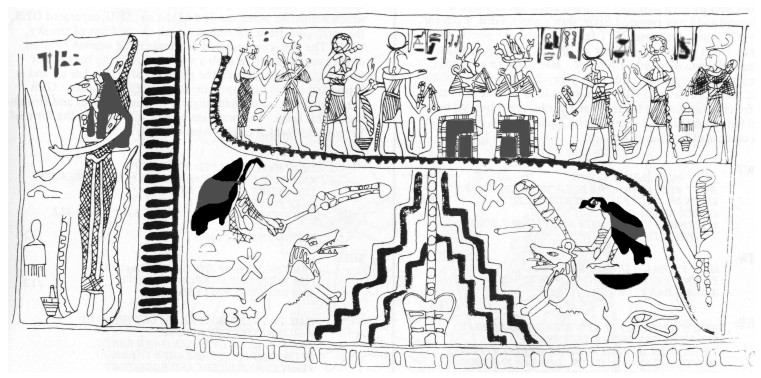W1982 Mound
The Mound Scene

This scene can be sub-divided into three. On the far left, standing in front of a door is a daemon holding two knives (the door looks to modern eyes somewhat like a ladder), she is ‘She who Embraces’. To the right of the door is a scene divided horizontally into two halves by a snake. Snakes are often protective and associated with rebirth. Osiris is often shown as being rejuvenated in the Netherworld within the coils of a snake. Below the snake is a double staircase upon which two open-mouthed animals (the devourer) rest their front paws and behind them are vultures holding feathers. Above the snake are two back-to-back seated figures (Osiris) with deities standing in front of them. The deities include Thoth, Heka and Isis. The whole represents Osiris enthroned on the primeval mound (the double staircase) of the Duat with the deity ‘She who Embraces’ guarding the door. This is a scene of the triumph of a successful judgement and resurrection, it is thus placed as the culmination of the other scenes of judgement on this coffin. The deceased has been judged worthy to become one with Osiris, and here Osiris is reborn from the primeval mound.
The deity ‘She who Embraces’ is most commonly depicted outside the door of the resurrection of Osiris from the mound, apparently protecting the god. She also sometimes appears in judgement scenes, and occasionally leads the deceased to Osiris. Her presence may plausibly be due to her feminine nature. Within the mound, the two gods, Osiris and the sun-god Re, merged and led to rebirth. While, male gods were, in Egyptian myth, able to reproduce, the presence of the female was necessary for a successful outcome. The ‘embracing’ aspect of her name might allude to this. The theme of embracing, in regard to rebirth, though usually shown by hands ‘embracing’ the newborn sun, is common in the 21st Dynasty. For more about this demon click here.
Below the snake is the Duat, indicated here by the stars. It is the place in which Osiris resides and from which amalgamation with the sun-god Re (an amalgamation essential for rebirth), takes place. Our scene shows the devourer standing each side of a double staircase within which is the sema sign. A vulture flanks each side. Both the motif of mound and that of the devourer, are important in judgement. The double staircase relates to the death and rebirth of Osiris. At Abydos the entrance before the Osiris Temple was called ‘Great Stair of the Lord of Abydos.’ Osiris was the ‘Lord of the Staircase’ in Book of the Dead spell 168. In the Pyramid Texts, the dead ascend to heaven by means of a staircase. The sema sign consists of 2 lungs attached to a trachea and is usually said to symbolise the union of Upper and Lower Egypt. Sema, in another form can also mean internment, as in Book of the Dead spell 17.
One of the allusions of the double staircase was to the hb-sd festival, a festival of the king’s rejuvenation. This is reinforced above the snake by the two forms of Osiris, back to back in the centre of this scene. This is the way kings are shown sitting in their hb-sd festivals. On either side of the two thrones of Osiris, one can see a symmetrical arrangement of gods identified by hieroglyphs and their headdresses. These gods are commonly shown approaching the throne of Osiris. Thoth with ibis head is shown each time in front of Osiris. On the right, behind Thoth, is Harakhty followed by Heka (god of magic). On the left is Harakhty followed by Heka and then Isis.